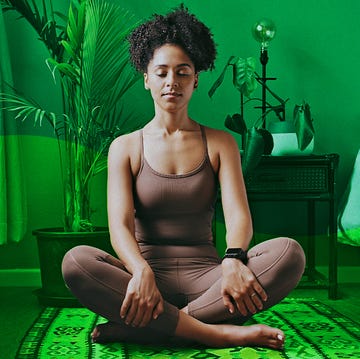The power of connecting to the breath as a tool to cultivate well-being and solve problems has long been known by elite athletes, first responders, and yogis alike. In response to the pandemic, breath work has grown in popularity for its benefits in stress reduction, healing trauma, and unlocking potential.
“Breath work, or pranayama, is mindful breathing,” New York-based yoga instructor and breath work expert Paula Reyes explains. “Regardless of simply observing my breath or trying to control my breath, I am — all the same — being mindful of it.”
Now, medical research in fields ranging from psychology to neuroscience is proving what spiritual teachers have known all along: Breath work helps us connect with the body in ways that allow stress, emotional pain, and stored trauma to be released, benefiting both our minds and bodies.
What is breath work?
Breath work is a term used to describe the modern application of breathing techniques culled from yoga, Buddhism, and other ancient practices and cultures that have been integrated and, in many cases, adapted for modern use in medicine, business, sports, and personal development.
Yoga is the primary way that most Westerners have been introduced to breath work, from ranging from the ujjayi, or ocean breath, that anchors vinyasa-based classes to the popular box-breathing method that many instructors use to center students before engaging in intense physical movement.
For the truest purpose of breath control, Reyes points to the Sanskrit word for it. “Pranayama can be broken down to ‘prana,’ as in ‘breath’ or ‘life-force energy,’ and ‘yama,’ as in ‘to control,’ or ‘ayama,’ as in ‘to extend’ or ‘expand,’” she deciphers, suggesting that on a metaphysical level, “breath work is the expansion of one’s life force.”
How can breath work cultivate mindfulness?
The easiest way to start with breath work is to simply become aware of your breath. We are always breathing, at most times unconsciously. Taking the time to pay attention to your breath taps into the mindfulness that’s necessary to feel your feelings and breathe through difficult moments.
Reyes advises beginning with a simple practice: “Without controlling or manipulating your breath, witness the next three cycles of breath you take,” she says. “Inhale, exhale. Inhale, exhale. Inhale, exhale. Notice, if any, how your body or mind may have shifted.”
In author Jack Kornfield’s book Meditation for Beginners, he teaches a method that begins with awareness of breath, moves on to sensations in the body, then focuses on emotions, feelings, and thoughts. This practice is called vipassana meditation and lays a foundation to receive the healing benefits of breath work.
What is box breathing?
Over the past three decades, research has shown that trauma is not only in the brain, but it's also stored at a cellular level in the body. Breath work can address both, according to Black Boys Om founder and A Healing Journal for Black Men author Danny Angelo Fluker Jr. “The heart of [breath work] is the mind-body connection,” he says. “There is power in tapping into the inherent interconnectedness of the mind and body and using the breath as a guide between both.”
Fluker notes that one of the greatest benefits of breath work is the “intimacy with our nervous system in controlling its regulation through breathing techniques.” He advises starting with box breathing, also known as tactical breathing in the military. “It’s grounding, downregulates the nervous system, and is a first step to healing any internalized stressors,” he says.
To box breathe, follow these steps: Sit in a comfortable position with your head above your heart in a supported posture with a lengthened spine. Inhale for four counts. Hold before exhaling for four counts. Hold before inhaling again for four counts. Exhale.
What is the A-B-C method?
South African physician Dr. Ela Manga teaches her clients to control their breath and make space for their feelings as a way to create new neural pathways with her A-B-C method, which stands for awareness, breath, and consciousness.
Manga’s method starts with being aware of what you are experiencing on all levels — mentally, emotionally, and physically — without doing anything about it. The next step is creating space for feelings by breathing into them. Finally, making a conscious choice and responding versus reacting to stress or trauma.
What is heart-focused breathing?
The power of intention coupled with slowed breathing is the cornerstone of a technique known as heart-focused breathing, or coherence. Developed by the HeartMath Institute, coherence can be accomplished while focusing your attention on your heart as you inhale and exhale, visualizing the breath moving in and out of your heart space, commonly referred to as “breathing through the heart.”
Research suggests coherence occurs in emotional states such as love, compassion, and empathy. It’s also associated with increased resilience. To accomplish heart-focused breathing, the HeartMath Institute recommends breathing deeply with inhales and exhales of five seconds each, resulting in about six breaths per minute.
What else can breath work accomplish?
The world of breath work and its transformative benefits are vast and still being explored by the medical community. Ultimately, we are always breathing, but breath work can bring us into the present moment, where many believe our greatest power lies.
According to Reyes, breathing also bonds us. “There is not only the physical body we can feel and do things with,” Reyes says. “There are also the many layers of the subtle body, the first of which is linked to our breath, that connect us with each other and the rest of the living universe, including animals and plants. Through breath, we are truly one.”
Tiffany Crawford is a writer, mindfulness and embodiment coach, and host of the podcast Healing the Feminine. Follow her on Twitter @thehouseofauset.
Get Shondaland directly in your inbox: SUBSCRIBE TODAY

















